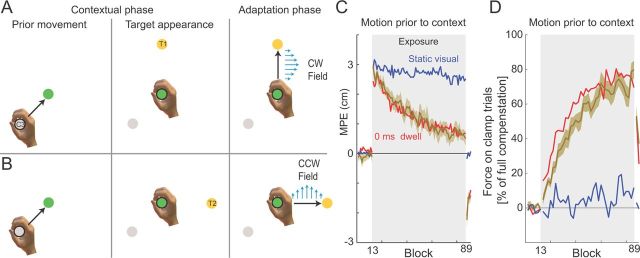Figure 5.
Motion before contextual information cues learning. A, Experimental design. The contextual phase comprised two components. Prior movement, The first movement (cue location to central target) occurred before the complete contextual information (presentation of target), which determined the force-field direction. The trial was initiated with the subject's hand at one of the cue locations (C3 in this case) while the central location was visually presented. The subject then moved to the central location. Target appearance, Once the subject was within the central location, the target appeared. Adaptation phase, Subjects then moved to the final target, and the force field was applied as soon as subjects initiated the movement. In this case, the previous movement from cue C3 combined with the current target presentation of T1 specified the CW force field. B, The identical previous movement from cue C3 to the central target was performed. However, in the target appearance phase, target T2 was presented. This combination specified the CCW force field on the adaptation phase of the movement. C, Mean MPE (green trace) and SE (green shaded region) across all subjects and blocks during the motion before contextual presentation experiment. For comparison, the mean results for the static visual (blue trace) and 0 ms dwell time (red trace) conditions are shown. Shaded gray region indicates the exposure period in which the two curl force fields were applied. D, Percentage force compensation computed from clamp trials throughout the experiment. The mean ± SE force over two blocks across subjects is plotted as a percentage of the force required for estimated complete compensation. For comparison, the mean results for the static visual normal (blue trace) and 0 ms dwell time (red trace) conditions are shown. Shaded region indicates exposure blocks in which the curl force fields were applied.

